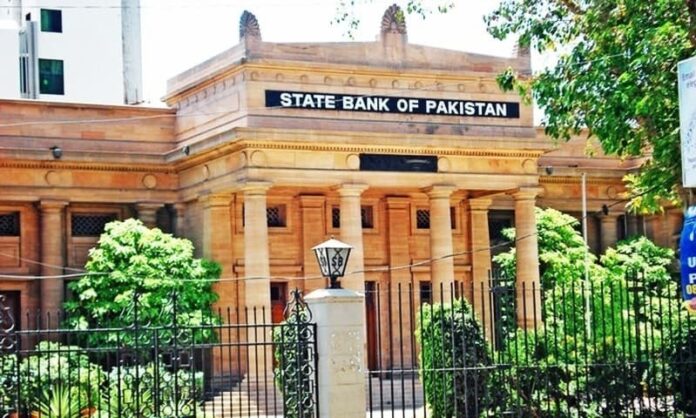KARACHI: Pakistan’s financial sector had sluggish growth during the early part of 2019, but began to stabilize towards the end of the year, according to a publication issued by the State Bank of Pakistan (SBP) on Monday.
The SBP’s annual publication, ‘Financial Stability Review for CY19’, reviews the performance and assesses the risk of banks, non-banking financial institutions, and the corporate sector.
As per the review, the consolidated asset base of the financial sector expanded by 11.74pc during the calendar year 2019, which was higher than the 7.46pc growth recorded in the previous year.
Most of this growth came from the banking sector, which is the largest segment of the financial sector.
“Financial markets—after remaining volatile in the first half of CY19—observed stability in the second half as operations in the foreign exchange market smoothed after the transition to a market-based exchange rate system,” the review noted.
According to the review, the equity market also showed a significant recovery towards the end of 2019, after having been volatile earlier in the year.
The SBP said the banking sector remained resilient, with robust solvency backed by healthy profitability.
The Capital Adequacy Ratio (CAR) improved to 17pc, well above global and domestic minimum regulatory requirements of 10.5pc and 11.5pc, respectively. Earnings of the banking sector surged by 14.3pc to Rs170 billion in 2019, a turn around after the contraction of the previous few years.
The higher interest income of the sector improved the Net Interest Margin (NIM) to 4pc, a 60 basis points rise over the last year. Accordingly, profitability indicators like the return on assets and equity also increased.
While demand for financing weakened, bank assets expanded by 11.73pc in 2019, primarily, due to a surge in investment in treasury instruments. Though asset quality saw some deterioration, most of the Non-Performing Loans continued to be fully provisioned. Encouragingly, the deposit base also exhibited a marked recovery, expanding by 11.92pc, and provided the resources to support asset growth.
Islamic Banking Institutions also saw their assets surge by 23.52pc, and their profitability also increased, bolstering the overall earnings of the banking sector. However, despite the healthy inflow into their deposits, these banks continue to face limited Sharia-compliant investment opportunities.
The performance of non-banking financial institutions remained steady in 2019, considering their risk-averse behaviour and a challenging environment. Their assets observed strong expansion of 58.12pc during 2019, mainly driven by 96.47pc expansion in investments. Advances growth accelerated to 11.63pc during 2019, against 7.39pc in 2018.
However, the review noted that the strategy of funding assets through short-term borrowing may not be sustainable in the long-term.
“Lack of longer tenor affordable funding remained a major challenge for DFIs in expanding their advances portfolio,” the review said.
The corporate sector assessment was based on a sample of the top 100 listed companies. The profitability and debt repayment capacity showed improvement while sales, solvency and asset efficiency indicators trended downwards in 2019. Automobiles, energy and cement sectors also faced major contractions in sales.
During the period under review, tighter financial conditions and higher input prices pushed the cost of doing business up and demands for goods down for the corporate sector. There was a deceleration in the growth of the corporate sector’s assets, to 7.1pc in CY19, against 16.1pc in CY18.
The review also stressed that stabilization measures had helped reduce the uncertainty from Pakistan’s external and fiscal imbalances by year-end 2019.
“There were early signs of an economic revival as foreign exchange reserves increased, the market-based exchange rate stabilized, the fiscal deficit contracted, and economic activity, particularly the Large Scale Manufacturing, revived,” noted the review.
COVID-19 SHOCK
According to the SBP, the banking sector should remain resilient to the Covid-19 shock under most reasonable shock scenarios, as per various stress tests that have been conducted. This, according to the SBP, reflects the strong capital and liquidity positions of the majority of banks. Strong capital buffers built over the years have also significantly enhanced the resilience of Pakistan’s banking sector.
The review noted that the ‘dismal impact’ of COVID-19 on Pakistan is still unfolding. SBP has taken a number of measures, such as substantial monetary easing; release of capital buffers; deferment of the repayment of the principal loan amount for corporate, SMEs, and household borrowers; restructuring of loans; concessionary financing to save jobs and boost health care to combat COVID-19; ensuring availability and continuity of financial services; and reduction in payment system-related costs.
According to SBP, these measures have started bearing results as banks have approved debt deferment of around Rs495 billion and rescheduling of PKR 70 billion to around seven hundred thousand borrowers. Under the refinance scheme to avoid layoffs, around Rs93 billion have been approved for 1,172 companies covering about eight hundred and fifty thousand employees.
























